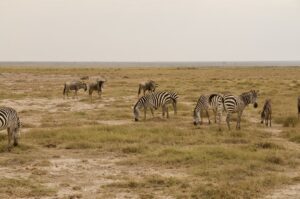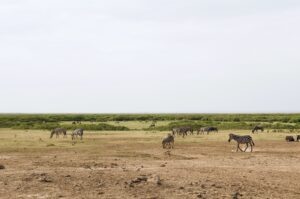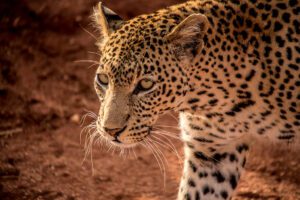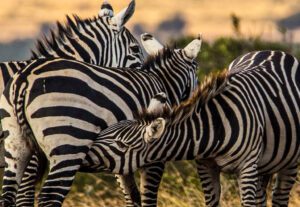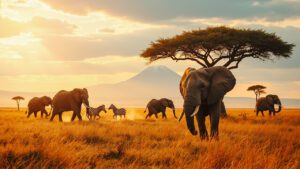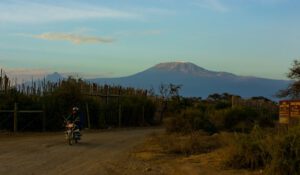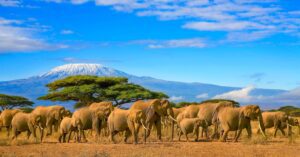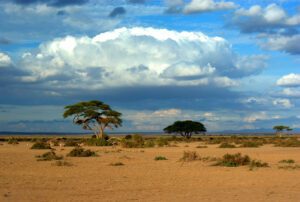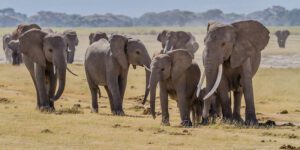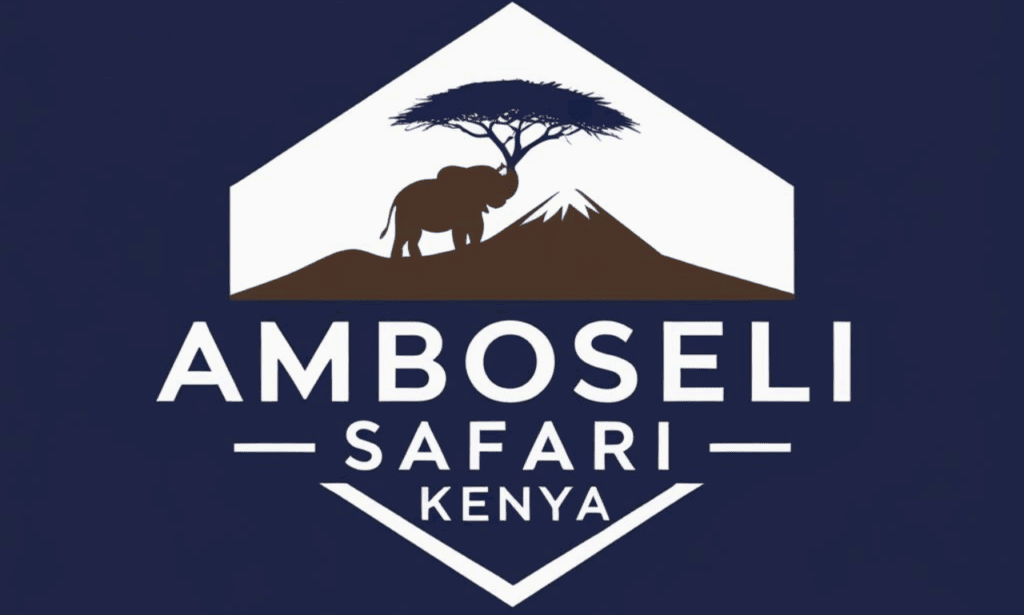Imagine standing on a vast, open plain, with curious elephants wandering nearby, and in the distance, the snow-capped majesty of Mount Kilimanjaro rises from the horizon like something out of a dream. Sounds magical, right? This is the incredible view you can experience from Amboseli National Park in Kenya, a place where nature feels larger than life. But why is Kilimanjaro so famous, and how can you see it so perfectly from Amboseli when the mountain is located in Tanzania? Let’s break it down in the simplest way possible, so you can fully appreciate what makes this view so special!
What is the significance of Mt. Kilimanjaro in relation to Amboseli National Park?
Mt. Kilimanjaro plays a key role in making Amboseli National Park one of the most iconic destinations for a Kenya safari. Kilimanjaro, the tallest mountain in Africa, is located in Tanzania but is visible from Amboseli, which lies just across the border in Kenya. This means visitors to Amboseli can enjoy stunning views of the mountain without needing to leave Kenya. The scenery here is special due to the stark contrast between the arid savannah landscape of the park and the towering, snow-capped peak of Kilimanjaro. The juxtaposition of the dry, golden grasslands filled with wildlife species against the lush, white peak of the mountain creates a picture-perfect scene that has become the subject of countless photos and postcards.
The mountain also indirectly sustains life in Amboseli. Kilimanjaro’s melting glaciers and seasonal rains feed underground water sources that emerge as springs in Amboseli. These springs maintain freshwater wetlands, which provide water for animals like elephants, hippos, and buffalo, even during the dry season. As a result, Mt. Kilimanjaro doesn’t just define the scenery, it helps support the ecosystem of Amboseli, making it a prime location for wildlife safaris.
Additionally, Kilimanjaro gives Amboseli a unique identity compared to other parks in Kenya. While Kenya is famous for safaris and wildlife, the backdrop of Mt. Kilimanjaro adds an extra layer of wonder and uniqueness to the Amboseli experience, making it a bucket-list destination for many travelers seeking an unforgettable safari experience.
Can Mt. Kilimanjaro be seen clearly from Amboseli, and under what conditions?
Yes, Mt. Kilimanjaro can often be seen clearly from Amboseli National Park, but visibility depends on certain conditions. One of the most important factors is the weather. Kilimanjaro is so tall (rising to 5,895 meters or 19,341 feet) that its peak is often surrounded by clouds. During the day, clouds tend to form around the mountain, obscuring the view, especially in the afternoon when heat causes air and clouds to rise. For an unforgettable safari experience, many visitors aim to catch a glimpse of this majestic peak during their Kenya safari.
However, the mountain is usually clearest during the early morning or late evening. When the air is cooler and calmer, there’s less cloud cover, which makes it easier to see the peak. For example, if someone wakes up just before sunrise in Amboseli, they’re likely to enjoy the most spectacular and uninterrupted view of Kilimanjaro, with its snow-covered summit glowing in the golden light. This moment is a highlight for wildlife photographers and those seeking the perfect shot of the African landscape.
Seasonal weather patterns also affect visibility. The dry season (from June to October and January to February) generally provides better viewing conditions, as there is less rain to create cloudy or hazy skies. In contrast, during the wet or rainy seasons, heavy clouds can block the view for days at a time, impacting the overall safari trip experience.
Lastly, certain spots within Amboseli, like elevated viewpoints or areas with an unobstructed horizon, offer clearer views. Timing and patience are key! Even if the mountain seems hidden, the clouds can shift at any moment to reveal its breathtaking grandeur, making it an essential part of any eco adventure safaris in Kenya.
What are the best times of year or day to view Mt. Kilimanjaro from Amboseli?
The best times of year to view Mt. Kilimanjaro from Amboseli are during the dry seasons, which occur from June to October and again from January to February. These months typically offer clearer skies with minimal rain, making it easier to spot the mountain. During the rainy seasons (March to May and November to December), heavy rainfall often creates persistent cloud cover that can obscure the view of Kilimanjaro, even for several days in a row. Travelers hoping for the best visibility should plan their kenya safari during the dry months to maximize their chances of seeing the mountain clearly.
The best times of day to view Kilimanjaro are early in the morning or late in the afternoon. Typically, right after dawn, the mountain is most visible because the cooler air keeps clouds from forming around the peak. Many safari guides in Amboseli recommend waking up early and enjoying the sunrise with Kilimanjaro in the background, it’s the most breathtaking and peaceful time to marvel at the african landscape. Similarly, in the late afternoon, just before sunset, there’s another good chance of seeing the mountain when clouds have thinned out for the day.
For example, a sunrise safari in Amboseli might allow you to catch elephants or zebras crossing the plains in silhouette against the softly lit Kilimanjaro, a truly remarkable and unforgettable experience. By planning your trip during the right time of year and being outdoors at the right moments of the day, you’re giving yourself the best possible chance to witness the full beauty of Kilimanjaro from Amboseli, a highlight of any safari experience.
How far is Amboseli National Park from Mt. Kilimanjaro?
Amboseli National Park, located in southern Kenya, is approximately 40 kilometers (about 25 miles) from the base of Mt. Kilimanjaro. While Amboseli lies in Kenya, the iconic mountain actually stands across the border in neighboring Tanzania. The proximity means that the towering presence of Kilimanjaro provides a dramatic backdrop to the flat plains of Amboseli, making it a prime destination for wildlife photographers. When conditions are clear, you get a postcard-perfect view of the mountain with its snowcapped peak rising above the surrounding dry savannah.
To give you some context, the distance (40 kilometers) is relatively small when viewed from Amboseli, which is why Mt. Kilimanjaro looks incredibly striking. Imagine standing at a vantage point like a lookout and seeing the tallest free-standing mountain in the world right on the horizon, enhancing your safari experience with breathtaking scenery.
The border between Kenya and Tanzania does not affect the visual experience. Kilimanjaro dominates the landscape no matter where you’re standing in Amboseli. To put the distance into perspective, it’s about the length of a 30-40-minute drive on a highway. Of course, there are no direct roads from Amboseli to Kilimanjaro for most visitors due to the international border, but its grand view is perfectly accessible within the park.
This relatively short distance is what makes Amboseli National Park one of the prime spots to see the mountain without actually being in Tanzania. It’s like getting the best of both worlds , explore Kenya’s rich wildlife and culture while enjoying views of Tanzania’s famed Kilimanjaro, all while experiencing the abundant wildlife of the park.
What wildlife and natural features enhance the viewing experience of Mt. Kilimanjaro at Amboseli?
The viewing experience of Kilimanjaro Mountain from Amboseli National Park is elevated by the incredible wildlife and unique natural features found within the park. Amboseli is often referred to as the “Land of Giants” because of its large elephant herds. These majestic herds, known for their long tusks, are frequently seen wandering across the plains with Mt. Kilimanjaro as the backdrop, making for one of the most iconic images in an African safari experience.
In addition to elephants, Amboseli is home to numerous other animals such as zebras, giraffes, cheetahs, lions, wildebeest, and a variety of antelope species. These creatures often graze or roam across the vast landscape, creating a dynamic and ever-changing foreground for wildlife photography enthusiasts aiming to capture Kilimanjaro’s beauty.
The natural landscape further enhances the view. Amboseli features expansive grasslands, marshes, and acacia woodlands, all of which frame Kilimanjaro in stunning ways. The park is dotted with small watering holes and seasonal swamps created by the melting snowcaps of Kilimanjaro itself. These wetlands attract flamingos, pelicans, and other bird species, providing a unique contrast to the dry savannahs.
Another highlight is the park’s consistent lighting conditions. During sunrise and sunset, the soft golden light enhances both the wildlife and the snowcapped peaks, creating vivid, unforgettable scenes. Imagine a family of giraffes silhouetted against a fiery orange sky with Kilimanjaro’s majestic summit in the background , it’s a sight that embodies the essence of a safari trip.
Overall, the combination of thriving wildlife, diverse ecosystems, and incredible views of Kilimanjaro creates a viewing experience unmatched by most other places.
Why is the view of Mt. Kilimanjaro from Amboseli unique compared to other viewpoints?
The view of Mt. Kilimanjaro from Amboseli is unique primarily because of the juxtaposition of Kenya’s wildlife and the stunning African landscape with the towering mountain in Tanzania. Amboseli is the only place where you can observe such a dramatic combination of wildlife species against the backdrop of Kilimanjaro. While Kilimanjaro can also be admired from Tanzania in places like Moshi or Arusha, those locations lack the same vibrant animal activity that Amboseli provides, making it a prime destination for a Kenya safari.
One reason this view is so special is the contrast between the dry, flat plains of Amboseli and the snow-capped peak of Mt. Kilimanjaro. Amboseli’s landscape is mostly open savannah, with only scattered acacia woodland dotting the horizon. This makes Kilimanjaro’s towering presence even more dramatic and overwhelming, as it seems to rise abruptly out of the plains, creating an iconic scene for wildlife photographers.
Additionally, the wildlife in Amboseli transforms the view into a living, breathing masterpiece. Herds of elephants, prides of lions, and grazing zebras all add a dynamic element to the scenery. It’s not just a static view of a mountain; it’s a scene full of life and movement, which makes it feel more magical. For instance, seeing elephants walking in the foreground with Kilimanjaro looming behind them is an experience that you can’t replicate elsewhere.
The cultural significance also plays a role in making the view unique. Amboseli is home to the Maasai people, and you might see Maasai herders with their cattle moving across the landscape. This cultural aspect deepens the connection to the land and its history, offering something you wouldn’t get in other viewpoints of Kilimanjaro, enriching your safari experience.
To summarize, the mix of wildlife, culture, and the dramatic flatness of Amboseli’s landscape, combined with the grandeur of Kilimanjaro, makes this view unlike any other. It’s what turns Amboseli into one of the world’s most sought-after vantage points for experiencing Africa’s tallest mountain, ensuring unforgettable safari experiences for all visitors.
Are there specific viewpoints or spots within Amboseli National Park that offer the best views of Mt. Kilimanjaro?
Yes, certain spots in Amboseli National Park are especially great for viewing Kilimanjaro Mountain. The best views are often from open plains within the park where the landscape is flat, and there’s nothing blocking the gorgeous sight of the mountain. Specifically, Observation Hill is a well-known viewpoint that gives a panoramic view of the park, including clear vistas of Kilimanjaro. It’s a small hill where you can climb up and get an elevated view of the entire park, with Kilimanjaro rising majestically in the background. This spot is especially good for seeing both wildlife species and the mountain together, making it a favorite for wildlife photographers.
Other great areas include locations near the waterholes and marshlands. Amboseli has many natural water sources where animals like African elephants, zebras, and flamingos gather, and these scenes often feature Kilimanjaro in the background. The mix of wildlife and the mountain is a view many people call magical. The iconic image of elephants walking across the savannahs with Kilimanjaro in the background is typically captured in open areas near these water bodies.
For the best safari experience, visiting at sunrise or sunset is ideal because the lighting enhances the mountain’s snowy peak and makes the scenery even more beautiful with warm, glowing colors. It’s also important to note that Kilimanjaro is most visible when the weather is clear, so spotting these viewpoints on a clear day will make all the difference.
In short, lookout points like Observation Hill, areas near waterholes, and the park’s open plains provide the best views of Mt. Kilimanjaro alongside Amboseli’s unique wildlife. Combining great locations and perfect timing ensures you won’t miss the perfect shot.
How does the cultural and geographical context of Amboseli influence the experience of viewing Mt. Kilimanjaro?
The experience of viewing Kilimanjaro Mountain from Amboseli National Park feels extra special because of the park’s cultural and geographical context. Amboseli sits in southern Kenya, near the border with Tanzania, where Mt. Kilimanjaro majestically rises from the flat plains. This dramatic elevation makes the mountain appear even larger and more impressive. The contrast between the open savannahs and this giant snow-capped mountain is one reason this view feels so unique.
Culturally, the park is home to the Maasai people, an indigenous tribe known for their rich traditions, colorful clothing, and unique way of life. The Maasai have lived in harmony with the land and the wildlife for generations, and their cultural presence adds depth to a visit to Amboseli. Visitors often get the chance to interact with the Maasai, learn about their customs, or see their traditional homesteads, called ‘manyattas.’ This cultural connection enhances the safari experience of viewing Kilimanjaro, as it feels like part of a larger story about the relationship between people, land, and nature.
Geographically, Amboseli is famous for being both a national park and a wildlife haven, known for its large elephant herds, zebras, giraffes, and even lions, all occurring right in the shadow of Kilimanjaro. It’s like nature itself has created a perfect setting where iconic African wildlife roams freely, framed by this majestic mountain.
In short, the view of Kilimanjaro isn’t just a pretty picture, it’s an experience rooted in the land’s culture, people, and geography. Seeing it in Amboseli makes you feel connected to the beauty of Africa’s traditions and natural wonders all at once.
What role do photography and tourism play in the popularity of viewing Mt. Kilimanjaro from Amboseli?
Photography and tourism are huge reasons why viewing Kilimanjaro Mountain from Amboseli is so popular! Amboseli National Park is considered one of the best places in the world for photography, and Mt. Kilimanjaro often serves as the “star” of these pictures. Many people dream of capturing photos of African wildlife, like the majestic herds of elephants, lions, or zebras, with the mountain in the background. This combination of dramatic landscapes and stunning animals makes Amboseli a bucket-list destination for photographers, both professionals and beginners.
For example, an image of elephants walking across the dusty plains with Kilimanjaro’s snow-capped peak towering behind them is one of the most iconic and recognizable scenes of Africa. Travel magazines, social media posts, and wildlife documentaries often feature this exact shot, inspiring visitors from all over the world to come and see it for themselves. Photography has a way of making the experience seem almost magical, which fuels tourism and attracts Africa safari experts who guide travelers in capturing these moments.
Tourism also plays a big role because Amboseli is easily accessible compared to other areas. Many visitors traveling from Nairobi or other parts of Kenya choose to include Amboseli on their safari itinerary specifically for the chance to see this famous view. While they’re there, people stay at nearby lodges or camps and join guided safaris into the park, boosting the local economy. Plus, the park’s connection to the Maasai culture gives tourists a chance to experience more than just wildlife and landscapes, offering a more complete and memorable visit.
In summary, photography has helped spread the beauty of Kilimanjaro and Amboseli’s wildlife to the world, making it a dream destination for travelers. Meanwhile, tourism supports the park, local communities, and conservation, ensuring that this iconic view remains protected for years to come. Together, they make Amboseli a special and sought-after location for any Kenya safari enthusiast.
Are there any guided tours or activities in Amboseli specifically focused on viewing Mt. Kilimanjaro?
Yes, there are guided tours and activities in Amboseli National Park specifically designed to provide visitors with stunning views of Mt. Kilimanjaro. Many of these tours are offered by local tour operators or lodges in and around the park. These tours typically focus on combining wildlife viewing with the beautiful backdrop of Africa’s highest mountain.
A popular activity is a game drive, where travelers ride in safari vehicles with knowledgeable guides who help them explore the park. While on these drives, guides know the best spots where both the wildlife and breathtaking views of Kilimanjaro can be seen simultaneously. You might, for instance, find yourself spotting a herd of elephants walking across open plains with the snow-capped peak of Kilimanjaro visible in the background – a picture-perfect scene!
Some tours begin early in the morning, when the mountain is most likely to be visible, as this is when the skies are clearest. Others might focus on sunset views, where the warm hues of the sun illuminate the mountain differently.
Photography tours are another type of activity tailored specifically for capturing Kilimanjaro. These tours are often led by professional photographers who teach participants how to frame pictures with the mountain and wildlife as subjects.
Some lodges and accommodations within Amboseli offer Kilimanjaro-centered experiences, such as “breakfast with a view,” where guests enjoy a meal while facing the mountain. Walking safaris led by Maasai guides are also increasingly popular. These tours provide a cultural element and offer visitors an opportunity to view the mountain’s beauty while learning about the Maasai people’s relationship with the region.
In summary, guided activities in Amboseli cater not only to nature lovers but also to anyone eager to experience Kilimanjaro up close – either through safaris, cultural tours, or photography-focused ventures.
How do weather patterns, such as cloud cover, impact the visibility of Mt. Kilimanjaro from Amboseli?
Weather plays a huge role in whether you’ll get to see Kilimanjaro Mountain when visiting Amboseli National Park. One of the biggest obstacles to viewing the mountain is cloud cover, which tends to obscure it for large parts of the day. During the dry seasons (from December to February and June to October), the weather is generally clearer, making it easier to see the mountain. Early mornings and late evenings are often the best times to catch a view of Kilimanjaro because the overnight cool temperatures help disperse any lingering clouds. As the day warms up, clouds tend to form around the mountain, and it may disappear from sight by late morning or afternoon.
During the dry seasons (from December to February and June to October), the weather is generally clearer, making it easier to see the mountain. Early mornings and late evenings are often the best times to catch a view of Kilimanjaro because the overnight cool temperatures help disperse any lingering clouds. As the day warms up, clouds tend to form around the mountain, and it may disappear from sight by late morning or afternoon.
Although the mountain isn’t visible all the time, many visitors are lucky enough to get clear views, especially when they plan their Kenya safari smartly. For example, staying in the park for more than just one day gives you better odds of catching a clear sight at different times of day. Patience and timing are key, and nature often rewards those willing to wait for that perfect moment!
If you’re keen on capturing the stunning African landscape and diverse wildlife, consider bringing a camera along during your safari trip. The Amboseli National Park is not just about the majestic views of Kilimanjaro; it also offers unique opportunities for wildlife photography, including sightings of elephants and other iconic species.
Ultimately, the experience at Amboseli can be enhanced by understanding the best times to view the mountain and the surrounding wildlife. With proper planning, your safari experience can be truly unforgettable, filled with the beauty of nature and the thrill of wildlife encounters.
What logistics, such as travel or accommodation, should one consider when planning a trip to view Mt. Kilimanjaro from Amboseli?
Planning a trip to Amboseli National Park to view Mt. Kilimanjaro involves a few key logistical considerations. First, you’ll need to figure out how to get there. Amboseli is located in southern Kenya, about 240 kilometers (150 miles) from Nairobi, the capital city. Most visitors travel by road, which typically takes 4-5 hours, though rough roads in some areas can extend the travel time. Alternatively, daily scheduled flights are available from Nairobi to Amboseli’s airstrip, cutting travel time significantly for those looking to maximize their safari experience.
Accommodation is another big consideration. There are numerous options inside and around Amboseli National Park to suit various budgets. For luxury travelers, there are high-end lodges like Tortilis Camp or Amboseli Serena Safari Lodge, which often offer additional services such as private game drives or scenic tours of Kilimanjaro. Budget-friendly travelers might opt for camping sites or mid-range lodges near the park. Choosing accommodation that advertises views of Mt. Kilimanjaro can help ensure you don’t miss out on those iconic vistas.
When planning, it’s essential to account for park fees. Amboseli National Park charges non-resident tourists an entrance fee, which is usually paid per day. Check current rates in advance (as they sometimes change) and bring cash or another accepted payment method to avoid any inconveniences during your Kenya safari.
Since Kilimanjaro’s visibility depends heavily on weather and timing, consider staying for two or three days to increase your chances of seeing the peak unobstructed. Also, pack appropriately for Amboseli’s environment: light, breathable clothing for the heat, but layers for the cool mornings and evenings. Don’t forget essentials like sunscreen, hats, binoculars, and a good camera for capturing the abundant wildlife and stunning landscapes.
Lastly, book your travel and accommodations well in advance, especially during the high tourist season (June to October), when availability may be more limited. Planning these details carefully will make your trip enjoyable and maximize your chances of seeing Kilimanjaro from this breathtaking vantage point, allowing you to fully appreciate the unique ecosystem of Amboseli National Park.
Wrapping It Up
So, what makes viewing Mt. Kilimanjaro from Amboseli National Park so special? We’ve explored the “what”, the stunning sight of Africa’s tallest mountain; the “how”, its breathtaking panorama framed by Amboseli’s iconic elephants, including the majestic herds that roam freely; and the “why”, the unique interplay of landscapes that feels almost magical. This view isn’t just about scenery; it’s about experiencing nature’s grandeur in a way that sticks with you. Next time you think about incredible places, let Kilimanjaro and the Kenya safari experiences inspire you to explore how nature connects us all. It’s a view worth dreaming of!

